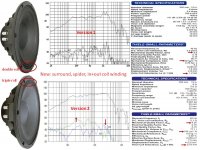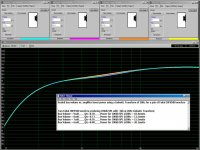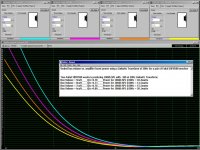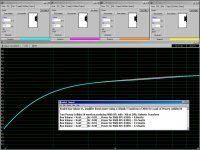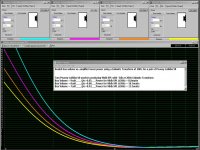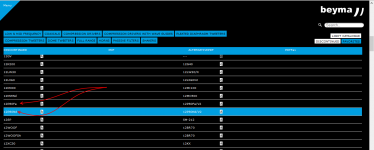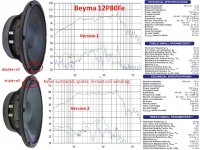As I continue to look into the 12P80Nd I came across the "new" sign on the Beyma website besides the 12P80Nd/V2. The data sheet notes "preliminary".
The frequency response looks smoother than the V1. The T/S parameters also change. Mms/Bl is 2.6 for the V2 vs. 2.4 for the V1. Maybe a slower driver, but with a more even frequency response?
Anybody knows if this is already available?
The frequency response looks smoother than the V1. The T/S parameters also change. Mms/Bl is 2.6 for the V2 vs. 2.4 for the V1. Maybe a slower driver, but with a more even frequency response?
Anybody knows if this is already available?
GUESS at: Beyma 12P80Nd changes between version1 vs. version2
New cone surround. Best way to tell V1 vs. V2
1) cone surround: old = double roll(M-roll); new = triple roll
New stiffer suspension spider.
2) Mechanical Compliance(surround + spider): old Cms = 227 um/N; new Cms = 180 um/N
New inside+outside windings on voice coil former
3) Le inductance: old = 1.2mH; new = 0.75mH
4) Bl: old = 23.1; new = 25.3
---V1 cone breakup between 1.6KHz - 3KHz has been removed in V2
---V2 looks like excellent partner for the TPL-150H with LR4@1.6Khz
---V2 has higher distortion 200Hz-500Hz, but lower distortion 2KHz-3KHz
New cone surround. Best way to tell V1 vs. V2
1) cone surround: old = double roll(M-roll); new = triple roll
New stiffer suspension spider.
2) Mechanical Compliance(surround + spider): old Cms = 227 um/N; new Cms = 180 um/N
New inside+outside windings on voice coil former
3) Le inductance: old = 1.2mH; new = 0.75mH
4) Bl: old = 23.1; new = 25.3
---V1 cone breakup between 1.6KHz - 3KHz has been removed in V2
---V2 looks like excellent partner for the TPL-150H with LR4@1.6Khz
---V2 has higher distortion 200Hz-500Hz, but lower distortion 2KHz-3KHz
Attachments
GUESS at: Beyma 12P80Nd changes between version1 vs. version2
New cone surround. Best way to tell V1 vs. V2
1) cone surround: old = double roll(M-roll); new = triple roll
New stiffer suspension spider.
2) Mechanical Compliance(surround + spider): old Cms = 227 um/N; new Cms = 180 um/N
New inside+outside windings on voice coil former
3) Le inductance: old = 1.2mH; new = 0.75mH
4) Bl: old = 23.1; new = 25.3
---V1 cone breakup between 1.6KHz - 3KHz has been removed in V2
---V2 looks like excellent partner for the TPL-150H with LR4@1.6Khz
---V2 has higher distortion 200Hz-500Hz, but lower distortion 2KHz-3KHz
Thanks for taking the time to look into it. Indeed, the V2 frequency response and lower distortion above 1.6 kHz makes it more appealieng than the V1 to mate with a TPL-150H.
How meaningful is the increased distortion in the 200-500Hz region?
Of course an option is to leave the range below 400 Hz or so to play through other woofer/s.
How meaningful is the increased distortion in the 200-500Hz region?
Harmonic distortion below 40db is considered inaudible.
Harmonic distortion above 20db is considered audible.
From the 12P80Nd V2 datasheet, harmonic distortion stays below 35db for the normal usage frequency range.
Audible concerns for harmonic distortion between 20db-40db depend partly on golden-ears and partly on design execution. In the 200-300Hz range a typical 3-way will have a crossover to the woofers and a baffle step compensation circuit which both significantly shape distortion and timbre accuracy. Exceptional crossovers will decide a Gold, Silver, Bronze medal design more than the harmonic distortion bumps.
The Lambda TD12M is often mentioned as having the lowest harmonic distortion for a 12" midbass. The attached measurement data shows at least -50db over the normal usage frequencies.
Attachments
Harmonic distortion below 40db is considered inaudible.
Harmonic distortion above 20db is considered audible.
From the 12P80Nd V2 datasheet, harmonic distortion stays below 35db for the normal usage frequency range.
Audible concerns for harmonic distortion between 20db-40db depend partly on golden-ears and partly on design execution. In the 200-300Hz range a typical 3-way will have a crossover to the woofers and a baffle step compensation circuit which both significantly shape distortion and timbre accuracy. Exceptional crossovers will decide a Gold, Silver, Bronze medal design more than the harmonic distortion bumps.
The Lambda TD12M is often mentioned as having the lowest harmonic distortion for a 12" midbass. The attached measurement data shows at least -50db over the normal usage frequencies.
Thank you. That was very helpful. The most likely scenario is I will end up with a 4-way active, where a TPL-150H will be at the top and two subwoofers will run up to 80 Hz or thereabouts. So I guess if I ran this V2 as midrange I would have a midbass woofer covering up to 300 or 400Hz and take care of the highest distortion seen on the graph. Or just keep it 3-way and take advantage of not having another crossover point in there.
The TD12M has impressive distortion performance. Yet it has significantly lower motor strength and higher Mms/Bl than the 12p80nd. I wonder if the AE sounds as fast in the midrange as the Beyma.
Mms/bl isn't an indicator of "fast" performance. High frequency extension and low stable inductance figures are much more important.
Or just keep it 3-way and take advantage of not having another crossover point in there.
I would construct a 3-way similar to the Tweek Geek BMF-1, and use your current subwoofers to experiment with Geddes-type multi-woofer placement to remove room bass modes.
There are very good BMF-1 construction photos on the Tweek Geek website. I still favor using a side-side pair of 18" woofers because of the dynamics and 100db/watt efficiency. The attached table illustrates how the cabinet volume can be changed if higher amplifier power is acceptable. Two 18" side-side woofers can produce 100db SPL 30Hz bass with just 10 watts of power in an 8cuft cabinet. Two 18" side-side woofers can produce 100db SPL 30Hz bass with just 20 watts of power in a more modest 6cuft cabinet. The TPL-150H and Beyma 12P80Nd are designed for high efficiency and dynamics, which requires two 18" woofers to keep up!
Sealed box volume vs. amplifier boost power using a Linkwitz Transform of 20Hz for a pair of Faital 18FH500
Two Peavey Faital 18FH500 woofers producing 100db SPL with -3db at 20Hz Linkwitz Transform
Box Volume = 9cuft____Qtc=0.70___Power for 100db SPL @30Hz = 10.4watts
Box Volume = 8cuft____Qtc=0.73___Power for 100db SPL @30Hz = 12.5watts
Box Volume = 7cuft____Qtc=0.76___Power for 100db SPL @30Hz = 15.5watts
Box Volume = 6cuft____Qtc=0.80___Power for 100db SPL @30Hz = 20.18watts
=======================================
Sealed box volume vs. amplifier boost power using a Linkwitz Transform of 20Hz for a pair of Peavey LoRider18
Two Peavey LoRider18 woofers producing 98db SPL with -3db at 20Hz Linkwitz Transform
Box Volume = 9cuft____Qtc=0.85___Power for 98db SPL @30Hz = 8.8watts
Box Volume = 8cuft____Qtc=0.88___Power for 98db SPL @30Hz = 10.7watts
Box Volume = 7cuft____Qtc=0.92___Power for 98db SPL @30Hz = 13.5watts
Box Volume = 6cuft____Qtc=0.98___Power for 98db SPL @30Hz = 17.8watts
Attachments
I would construct a 3-way similar to the Tweek Geek BMF-1, and use your current subwoofers to experiment with Geddes-type multi-woofer placement to remove room bass modes.
I've done the Geddes approach. I had my B&W 804S playing full range (so, getting down to 40 Hz, let's say), plus the two subs tried in multiple different locations according to the guidelines by Dr Geddes. My subs have the added benefit of not only allowing for phase adjustments, but also PEQ (selecting a frequency, a width around it, and add/substract dB there). Results were good, but I would say the improvement in the way they measured was larger than the improvement in how it sounded to me. The main goal of the approach is to even out bass response around the room. But I listen sitting in one place I guess.
Right now my subs are sitting in each front corner, set up as stereo subs. Each receives the full range signal from the preamp, and outputs the signal above 80Hz to my tube amp. So now the speakers are reproducing above 80Hz and subs below, and a cheap crossover in between, and I like it better. It seems the benefits of relieving the amp and speakers from attempting to reproduce the lower frequencies out weighs the benefit of having 4 low bass sources vs 2.
On top of it I am now using Acourate for room correction and the improvement in sound has been significant. So I'm rather unlikely to go back to two full range speakers plus subwoofers.
There are very good BMF-1 construction photos on the Tweek Geek website. I still favor using a side-side pair of 18" woofers because of the dynamics and 100db/watt efficiency. The attached table illustrates how the cabinet volume can be changed if higher amplifier power is acceptable. Two 18" side-side woofers can produce 100db SPL 30Hz bass with just 10 watts of power in an 8cuft cabinet. Two 18" side-side woofers can produce 100db SPL 30Hz bass with just 20 watts of power in a more modest 6cuft cabinet. The TPL-150H and Beyma 12P80Nd are designed for high efficiency and dynamics, which requires two 18" woofers to keep up!
Having the two subs at the bottom range, I was thinking I could use a front-firing 12" driver to cover in between sub and 300-400 Hz. Maybe I could experiment with a lower xo between sub and midbass. This driver would need to account for bafle step loss, but it doesn't seem to be an issue.
BTW, when you say those drivers are designed for efficiency and dynamics, what do you mean by dynamics? Do they need to be played at 100dB SPL to come alive? How do they perform at 80dB SPL (C-weighted)?
I strongly doubt someone will hear a difference between the old and new version. They are too similar.
I would cross it at max 80hz to a sub, and at 1,6khz. The beauty of this driver is that it plays in a wide frequency range with unmatched speed and natural timbre.
I would cross it at max 80hz to a sub, and at 1,6khz. The beauty of this driver is that it plays in a wide frequency range with unmatched speed and natural timbre.
Oh, the speed! It's so fast, cone breakup is inaudible. By the time you get to hear breakup the next note is already upon us!
how do you estimate if a cone driver is faster/slower than the other? what characteristics count here?
Going by manufacturers curves (mainly BMS and Beyma) it seems that ferrite-magnet versions of their drivers have slightly less THD than the Nd equivalents.
Given that Fe versions are also a fair bit cheaper (in this case £147 for Fe magnets & £233 for Nd) why would one use the Nd version unless it is for a touring PA?
Given that Fe versions are also a fair bit cheaper (in this case £147 for Fe magnets & £233 for Nd) why would one use the Nd version unless it is for a touring PA?
Last edited:
Going by manufacturers curves (mainly BMS and Beyma) it seems that ferrite-magnet versions of their drivers have slightly less THD than the Nd equivalents.
Given that Fe versions are also a fair bit cheaper (in this case £147 for Fe magnets & £233 for Nd) why would one use the Nd version unless it is for a touring PA?
I'd like to know about this, too...
Going by manufacturers curves (mainly BMS and Beyma) it seems that ferrite-magnet versions of their drivers have slightly less THD than the Nd equivalents.
Given that Fe versions are also a fair bit cheaper (in this case £147 for Fe magnets & £233 for Nd) why would one use the Nd version unless it is for a touring PA?
Dear Charles, how are you, the chinese authorities warmly recommend you Nd, thanks for agreeing on this excellent choice and for supporting our / your business!

I'd like to know about this, too...
Beyma also released a version2 of the 12P80Fe driver which appears to now have the same new cone, surround, suspension, and voice coil as the version2 of the 12P80Nd driver.
According to the Beyma datasheets, the Nd version has a stronger motor, lower Le voice coil and lower Fs, lower Qts.... The Nd verions also appears to have smoother SPL over the 1kHz-3kHz frequency range which is often important for marriage to a horn-compression_driver or Beyma TPL-150H
A designer will want to simulate both drivers to select the best performance and cost/benefit.
Attachments
I'm waiting for the 15P80Nd V2, but I don't know if they have such a plan....
Beyma has already released three different versions(datasheets) of the 15P80/Nd
ver...Qts......Fs
#1...0.21...35Hz
#2...0.34...54Hz
#3...0.178...33Hz
- Status
- Not open for further replies.
- Home
- Loudspeakers
- Multi-Way
- New Beyma 12P80Nd/V2?
